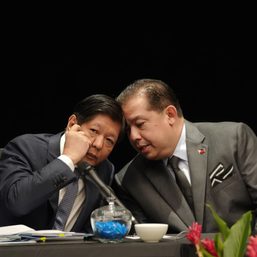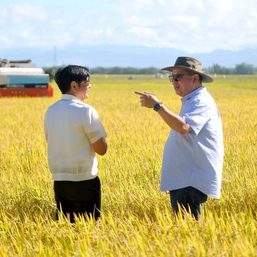SUMMARY
This is AI generated summarization, which may have errors. For context, always refer to the full article.
![[ANALYSIS] Price of rice in the world market? No such thing](https://www.rappler.com/tachyon/2023/09/TL-price-rice-world-market-September-12-2023.jpg)
We are republishing this from marengwinniemonsod.ph with permission from the author.
“Prices of rice in world market plummet by 22% following PHL price ceiling“. This was the headline of the press release of the House of Representatives issued on September 7, and I stared at it in complete disbelief.

But sure enough, the press release quoted Speaker Martin Romualdez as saying that “the huge reduction” [in the prices of rice in the global market] “can be attributed to the recent implementation of EO 39”. (Read my last blog: EO 39 makes no sense) imposing nationwide rice price ceilings.
He further crowed, “It is proven that the EO 39 of President (Ferdinand) Bongbong R. Marcos Jr. set commendable results not only in our country, (but in the world as well).”
The basis of Romualdez’ “huge reduction” in world prices, per the release, was this: “According to US-based Market Insider, the price of rice in the world market decreased from $384 per metric ton last July to $332.4 per metric ton this month.”
No price of rice in the world market
Reader, the United Nations Food and Agriculture Organization (FAO) – please google FAO Rice Price Update – “provides monthly rice export prices from major origins and is released monthly.” The Update also provides the FAO Rice Price Indices: the All Rice Price Index, which in turn is based on the weighted trade shares of the of: the Indica Index, the Aromatics Index, the Japonica Index, and the Glutinous Index. Moreover, the Update provides a commentary on recent market developments, which includes global rice supply and demand prospects. Pretty comprehensive, don’t you think?
You see, Reader, there is no such thing as “the price of rice in the world market”, as quoted above. There are only the overall price indices, and the export prices of major exporting countries. Plus, the latest FAO Rice Price Update came out on September 8, one day after the Romualdez press release. It shows that the August rice price indices were higher compared to those in July, and even higher compared to August 2022: “The All Rice Price Index increased by 9.8% in August 2023 to reach 142.4 points. At that level, the Index stood at 31.2% above its earlier value and at a 15-year nominal high. (Emphasis mine)
The US is not the ‘world market’
This pattern is necessarily similar (because it is based on them) to that showed by the export prices of the major exporting countries. The significant exception is the United States, which showed export prices decreasing from July to August for both US#1 and US#2 rice, and also decreasing from last August for US#1. But the US is a relatively small player in the international rice market, producing roughly half of what the Philippines produces, and exporting about 2 million metric tons (MMT) a year, compared to Vietnam’s 6.8MMT or Thailand’s 8.2MMT.
So, based on the evidence presented above, there has been no huge reduction in the internationally traded prices of rice. If anything, there has been a huge increase. So, what was “US-based Market Insider” talking about?
The US ‘source’ referring to futures prices
I could not read for myself the Market Insider report alluded to in the Romualdez press release, but according to an analyst who does not wish to be named, the price decrease “from $384 per MT last July to $332.4 this month” refers to the rough rice (palay) futures prices traded in the Chicago Board of Trade, which is part of the Chicago Mercantile Exchange Group (CMEG). True enough, googling CMEG, the analyst was correct.
And what are rough rice futures? They are tradable, standardized contracts to receive or deliver a specified quantity of rough rice on a future date, at a pre-agreed price. They are definitely not current prices.
In sum, Speaker Romualdez:
1) used completely erroneous data – futures prices instead of current prices
2) used data on rough rice which is produced in the United States (specifically, mostly in Arkansas and Mississipi)
3) rough rice is traded mostly between the US and Latin America, and which, being a tiny fraction of the international trade in rice, does not affect us in any way, much less Vietnamese and Thailand and the rest of Asia – to come to the conclusion that world prices plummeted.
Was that stupidity or cupidity?
Stupidity for failing to ask the Department of Agriculture (DA), or Philippine Institute for Development Studies, or his Congressional research staff, or any of that research group supposedly managed by the Ateneo with which he signed a Memorandum of Agreement, after all; cupidity – to make political points for the next election? Either answer reflects badly on the Philippine political leadership.
Beware post hoc ergo propter hoc
But for him to come to the conclusion that rice prices plummeted BECAUSE the President imposed price ceilings is even worse. It goes beyond the boundaries of stupidity and cupidity; he has fallen into a logical pitfall – the post hoc ergo propter hoc fallacy (“after this, therefore because of this”, where one event is thought to cause a later event just because it happened earlier) – one that a freshman economics student is warned about in the first lecture he attends.
The hoarders and their ‘import rice plans’
Add to that he makes a baseless explicit assumption that hoarders and manipulators have cancelled their rice import plans (a demand decrease, ergo cp price decrease) as a result of the price cap. Why should anybody have had import plans in the first place when it is the start of harvest season, and when the DA and the President already proclaimed that we have in place sufficient supply (production + imports), i.e., no need to import any more?
Or maybe his deathless desire to brown-nose his cousin – does he want to succeed him? – has warped his judgment beyond recall.
Or maybe we are not faced with an either-or situation here – either stupidity or cupidity. Maybe it is a both-and situation.
In any case, what are we to expect from this kind of leadership? – Rappler.com
Solita “Winnie” Monsod was the first National Economic and Development Authority secretary appointed after the fall of the Marcos dictatorship in 1986. She is a professor emerita at the UP School of Economics where she taught starting 1983. She finished her degree in economics in UP and obtained her masters in economics at the University of Pennsylvania. She is a board director of Rappler Inc.
1 comment
How does this make you feel?

![[In This Economy] The bad economics of Marcos’ rice price ceilings](https://www.rappler.com/tachyon/2023/09/20230905-bad-economics-marcos-price-ceiling.jpg?fit=449%2C449)



![[ANALYSIS] How one company boosts farmer productivity inside the farm gate](https://www.rappler.com/tachyon/2024/06/bioprime-farmgate-farmer-productivity-boost.jpg?resize=257%2C257&crop=465px%2C0px%2C1080px%2C1080px)










Thanks to Prof. Solita “Winnie” Monsod for revealing a Disinformation act committed by House Speaker Romualdez. I believe Speaker Romualdez has been recently Over-Excited on the possible outcome of the impeachment case against VP Sara Duterte on the issue of the 2022 OVP Confidential Fund. He really do want to succeed his cousin – President Marcos Jr. Hence, we should expect more propaganda campaigns from Speaker Romualdez, but for his kind of leadership – just ask the “bobotantes” who voted for him.